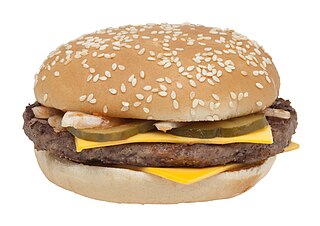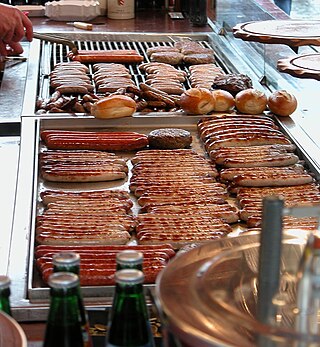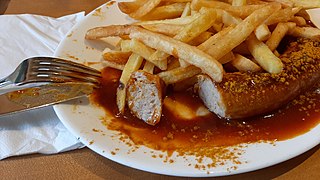
The cuisine of Germany consists of many different local or regional cuisines, reflecting the country's federal history. Germany itself is part of the larger cultural region of Central Europe, sharing many culinary traditions with neighbouring countries such as Poland and the Czech Republic. In Northern Europe, in Denmark more specifically, the traditional Danish cuisine had also been influenced by German cuisine in the past, hence several dishes being common between the two countries.

The cuisine of the American Midwest draws its culinary roots most significantly from the cuisines of Central, Northern and Eastern Europe, and Indigenous cuisine of the Americas, and is influenced by regionally and locally grown foodstuffs and cultural diversity.

A hamburger, also called a burger, is a food consisting of fillings—usually a patty of ground meat, typically beef—placed inside a sliced bun or bread roll. The patties are often served with cheese, lettuce, tomato, onion, pickles, bacon or chilis with condiments such as ketchup, mustard, mayonnaise, relish or a "special sauce", often a variation of Thousand Island dressing and are frequently placed on sesame seed buns. A hamburger patty topped with cheese is called a cheeseburger.
Brunch is a meal, sometimes accompanied by alcoholic drinks, taken sometime in the late morning or early afternoon – the universally accepted time is 10am-1pm. The meal originated in the British hunt breakfast. The word brunch is a portmanteau of breakfast and lunch. The word originated in England in the late 19th century, and became popular in the United States in the 1930s.

A hot dog is a dish consisting of a grilled, steamed, or boiled sausage served in the slit of a partially sliced bun. The term hot dog can refer to the sausage itself. The sausage used is a wiener or a frankfurter. The names of these sausages commonly refer to their assembled dish. Hot dog preparation and condiments vary worldwide. Typical condiments include mustard, ketchup, relish, onions in tomato sauce, and cheese sauce. Other toppings include sauerkraut, diced onions, jalapeños, chili, grated cheese, coleslaw, bacon and olives. Hot dog variants include the corn dog and pigs in a blanket. The hot dog's cultural traditions include the Nathan's Hot Dog Eating Contest and the Oscar Mayer Wienermobile.

Bratwurst is a type of German sausage made from pork or, less commonly, beef or veal. The name is derived from the Old High German Brätwurst, from brät-, finely chopped meat, and Wurst, sausage, although in modern German it is often associated with the verb braten, to pan fry or roast. Beef and veal are usually incorporated amongst a blend often including pork. Beef or veal is usual in halal and kosher Bratwurst sausages, which never include pork for religious reasons.

Chorizo is a type of pork sausage originating from the Iberian Peninsula. It is made in many national and regional varieties in several countries on different continents. Some of these varieties are quite different from each other, occasionally leading to confusion or disagreements over the names and identities of the products in question.

Danish cuisine originated from the peasant population's own local produce and was enhanced by cooking techniques developed in the late 19th century and the wider availability of goods during and after the Industrial Revolution. Open sandwiches, known as smørrebrød, which in their basic form are the usual fare for lunch, can be considered a national speciality when prepared and garnished with a variety of ingredients. Hot meals are typically prepared with meat or fish. Substantial meat and fish dishes includes flæskesteg and kogt torsk with mustard sauce and trimmings. Ground meats became widespread during the industrial revolution and traditional dishes that are still popular include frikadeller, karbonader and medisterpølse. Denmark is known for its Carlsberg and Tuborg beers and for its akvavit and bitters, but amongst the Danes themselves imported wine has gained steadily in popularity since the 1960s.

The cuisine of New York City comprises many cuisines belonging to various ethnic groups that have entered the United States through the city. Almost all ethnic cuisines are well represented in New York, both within and outside the various ethnic neighborhoods.

Currywurst is a fast food dish of German origin consisting of steamed, fried sausage, usually pork, typically cut into bite-sized chunks and seasoned with curry ketchup, a sauce based on spiced ketchup or tomato paste topped with curry powder, or a ready-made ketchup seasoned with curry and other spices. The dish is often served with french fries.

A fish fry is a meal containing battered or breaded fried fish. It usually also includes french fries, coleslaw, macaroni salad, lemon slices, tartar sauce, hot sauce, malt vinegar and dessert. Some Native American versions are cooked by coating fish with semolina and egg yolk.
When the predecessor of international fast food restaurant chain Burger King (BK) first opened in 1953, its menu predominantly consisted of hamburgers, French fries, soft drinks, milkshakes, and desserts. After being acquired by its Miami, Florida franchisees and renamed in 1954, BK began expanding its menu by adding the Whopper sandwich in 1957, and has since added non-beef items such as chicken, fish, and vegetarian offerings, including salads and meatless sandwiches. Other additions include a breakfast menu and beverages such as Icees, juices, and bottled waters. As the company expanded both inside and outside the United States, it introduced localized versions of its products that conform to regional tastes and cultural or religious beliefs. To generate additional sales, BK occasionally introduces limited-time offers of special versions of its products, or brings out completely new products intended for either long- or short-term sales. Not all of these products and services have been successful; in 1992, Burger King introduced limited table service featuring special dinner platters, but this concept failed to generate interest and was discontinued.

Olivier salad is a traditional salad dish of Russian cuisine. Its creation is generally attributed to Lucien Olivier.

The cuisine of the Mid-Atlantic states encompasses the cuisines of the states of New York, New Jersey, Pennsylvania, Delaware, and Maryland, as well as Washington, D.C. The influences on cuisine in this region of the United States are extremely eclectic owing to the fact that it has been and continues to be a gateway for international culture as well as a gateway for new immigrants.

Cricket Cafe is a restaurant in Portland, Oregon. The cafe's slogan is "champions of breakfast", offering the meal throughout the day with additional lunch options. It has received a generally positive reception, especially for its Bloody Marys, vegetarian options, and biscuits and gravy. Previously owned by Dan Bartkowski, the cafe closed unexpectedly in June 2017. Gordon Feighner and Katie Prevost reopened Cricket Cafe months later.

Dockside Saloon and Restaurant, or simply Dockside, is a diner and dive bar in Portland, Oregon, United States. Established in 1986, the nautical-themed, New American restaurant is known for being where incriminating evidence against Tonya Harding related to the assult of Nancy Kerrigan was dumped in 1994.













